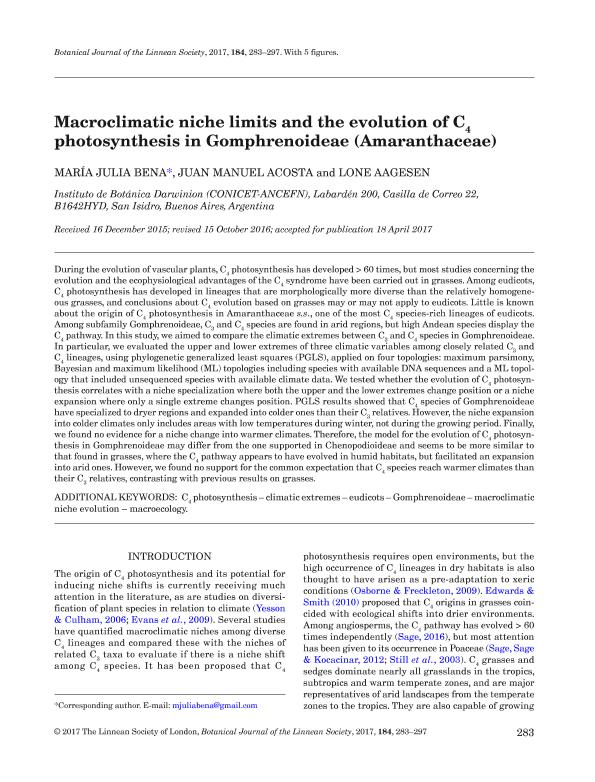Mostrar el registro sencillo del ítem
dc.contributor.author
Bena, María Julia

dc.contributor.author
Acosta, Juan Manuel

dc.contributor.author
Aagesen, Lone

dc.date.available
2018-05-04T20:49:12Z
dc.date.issued
2017-07
dc.identifier.citation
Bena, María Julia; Acosta, Juan Manuel; Aagesen, Lone; Macroclimatic niche limits and the evolution of C4 photosynthesis in Gomphrenoideae (Amaranthaceae); Oxford University Press; Botanical Journal of The Linnean Society; 184; 3; 7-2017; 283-297
dc.identifier.issn
0024-4074
dc.identifier.uri
http://hdl.handle.net/11336/44227
dc.description.abstract
During the evolution of vascular plants, C4 photosynthesis has developed > 60 times, but most studies concerning the evolution and the ecophysiological advantages of the C4 syndrome have been carried out in grasses. Among eudicots, C4 photosynthesis has developed in lineages that are morphologically more diverse than the relatively homogeneous grasses, and conclusions about C4 evolution based on grasses may or may not apply to eudicots. Little is known about the origin of C4 photosynthesis in Amaranthaceae s.s., one of the most C4 species-rich lineages of eudicots. Among subfamily Gomphrenoideae, C3 and C4 species are found in arid regions, but high Andean species display the C4 pathway. In this study, we aimed to compare the climatic extremes between C3 and C4 species in Gomphrenoideae. In particular, we evaluated the upper and lower extremes of three climatic variables among closely related C3 and C4 lineages, using phylogenetic generalized least squares (PGLS), applied on four topologies: maximum parsimony, Bayesian and maximum likelihood (ML) topologies including species with available DNA sequences and a ML topology that included unsequenced species with available climate data. We tested whether the evolution of C4 photosynthesis correlates with a niche specialization where both the upper and the lower extremes change position or a niche expansion where only a single extreme changes position. PGLS results showed that C4 species of Gomphrenoideae have specialized to dryer regions and expanded into colder ones than their C3 relatives. However, the niche expansion into colder climates only includes areas with low temperatures during winter, not during the growing period. Finally, we found no evidence for a niche change into warmer climates. Therefore, the model for the evolution of C4 photosynthesis in Gomphrenoideae may differ from the one supported in Chenopodioideae and seems to be more similar to that found in grasses, where the C4 pathway appears to have evolved in humid habitats, but facilitated an expansion into arid ones. However, we found no support for the common expectation that C4 species reach warmer climates than their C3 relatives, contrasting with previous results on grasses.
dc.format
application/pdf
dc.language.iso
eng
dc.publisher
Oxford University Press

dc.rights
info:eu-repo/semantics/openAccess
dc.rights.uri
https://creativecommons.org/licenses/by-nc-sa/2.5/ar/
dc.subject
C4 Photosynthesis
dc.subject
Climatic Extremes
dc.subject
Eudicots
dc.subject
Macroecology
dc.subject.classification
Otras Ciencias Biológicas

dc.subject.classification
Ciencias Biológicas

dc.subject.classification
CIENCIAS NATURALES Y EXACTAS

dc.title
Macroclimatic niche limits and the evolution of C4 photosynthesis in Gomphrenoideae (Amaranthaceae)
dc.type
info:eu-repo/semantics/article
dc.type
info:ar-repo/semantics/artículo
dc.type
info:eu-repo/semantics/publishedVersion
dc.date.updated
2018-05-04T15:10:33Z
dc.journal.volume
184
dc.journal.number
3
dc.journal.pagination
283-297
dc.journal.pais
Reino Unido

dc.journal.ciudad
Oxford
dc.description.fil
Fil: Bena, María Julia. Consejo Nacional de Investigaciones Científicas y Técnicas. Instituto de Botánica Darwinion. Academia Nacional de Ciencias Exactas, Físicas y Naturales. Instituto de Botánica Darwinion; Argentina
dc.description.fil
Fil: Acosta, Juan Manuel. Consejo Nacional de Investigaciones Científicas y Técnicas. Instituto de Botánica Darwinion. Academia Nacional de Ciencias Exactas, Físicas y Naturales. Instituto de Botánica Darwinion; Argentina
dc.description.fil
Fil: Aagesen, Lone. Consejo Nacional de Investigaciones Científicas y Técnicas. Instituto de Botánica Darwinion. Academia Nacional de Ciencias Exactas, Físicas y Naturales. Instituto de Botánica Darwinion; Argentina
dc.journal.title
Botanical Journal of The Linnean Society

dc.relation.alternativeid
info:eu-repo/semantics/altIdentifier/doi/http://dx.doi.org/10.1093/botlinnean/box031
dc.relation.alternativeid
info:eu-repo/semantics/altIdentifier/url/https://academic.oup.com/botlinnean/article-abstract/184/3/283/3884487
Archivos asociados
